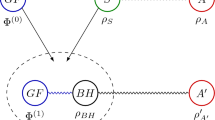Abstract
One of the outstanding puzzles of theoretical physics is whether quantum information indeed gets lost in the case of black hole (BH) evaporation or accretion. Let us recall that quantum mechanics (QM) demands an upper limit on the acceleration of a test particle. On the other hand, it is pointed out here that, if a Schwarzschild BH exists, the acceleration of the test particle would blow up at the event horizon in violation of QM. Thus the concept of an exact BH is in contradiction with QM and quantum gravity (QG). It is also reminded that the mass of a BH actually appears as an integration constant of Einstein equations. And it has been shown that the value of this integration constant is actually zero! Thus even classically, there cannot be finite mass BHs though zero mass BH is allowed. It has been further shown that during continued gravitational collapse, radiation emanating from the contracting object gets trapped within it by the runaway gravitational field. As a consequence, the contracting body attains a quasi-static state where outward trapped radiation pressure gets balanced by inward gravitational pull and the ideal classical BH state is never formed in a finite proper time. In other words, continued gravitational collapse results in an ‘eternally collapsing object’ which is a ball of hot plasma and which is asymptotically approaching the true BH state with M = 0 after radiating away its entire mass energy. And if we include QM, this contraction must halt at a radius suggested by the highest QM acceleration. In any case no event horizon (EH) is ever formed and in reality, there is no quantum information paradox.
Similar content being viewed by others
References
Arun Pati, Euro. Phys. Lett. 18, 285 (1992)
Arun Pati, Il Nuovo Cimento B107, 895 (1992)
E R Caianiello et al, Int. J. Mod. Phys. D3(2), 485 (1994)
A Mitra, Found. Phys. Lett. 15(5), 439 (2002)
G Horowitz, hep-th/9210119 (1992)
A Strominger, Nucl. Phys. B451, 109 (1995), hep-th/954090
V A Belinski, Phys. Lett. A354, 249 (2006), gr-qc/060713
M Rabinowitz, astro-ph/0412101 (2004)
A Mitra, Adv. Sp. Res. 38(12), 2917 (2006), astro-ph/0510162
A Mitra, J. Math. Phys. 50(4), 0242502 (2009), arXiv:0904.4754
A Mitra, physics/0504076 (2005)
A Mitra, Proc. 11th Marcel Gross Conf. on General Relativity (World Scientific, Singapore, 2008) p. 2276
A Mitra, Found. Phys. Lett. 13(6), 543 (2000)
A Mitra, astro-ph/0408323 (2004)
A Mitra, gr-qc/0512006 (2005)
D Leiter and S R Robertson, Found. Phys. Lett. 16, 143 (2003)
A Mitra, Mon. Not. R. Astron. Soc. Lett. 367, L66 (2006), gr-qc/061025
A Mitra, Mon. Not. R. Astron. Soc. 369, 492 (2006), gr-qc/0603055
A Mitra, Phys. Rev. D74(2), 02010 (2006), gr-qc/0606066
A Mitra, New Astronomy 12(2), 146 (2006), astro-ph/0608178
A Mitra and N K Glendenning, eScholarship Repository, Lawrence Berkeley National Laboratory, University of California (2006) see, http://repositories.cdlib.org/lbnl/LBNL-59320.
S Robertson and D Leiter, Astrophys. J. 565, 447 (2002)
S Robertson and D Leiter, Astrophys. J. 569, L203 (2003)
S Robertson and D Leiter, Mon. Not. R. Astron. Soc. 350, 1391 (2004)
R Schild, D Leiter and S Robertson, Astronom. J. 132(1), 420 (2006)
R Schild, D Leiter and S Robertson, Astronom. J. 135(3), 947 (2008)
Arun Pati and S L Baurstein, Phys. Rev. Lett. 98(8), 080502 (2007)
Author information
Authors and Affiliations
Corresponding author
Rights and permissions
About this article
Cite this article
Mitra, A. Quantum information paradox: Real or fictitious?. Pramana - J Phys 73, 615–622 (2009). https://doi.org/10.1007/s12043-009-0113-9
Published:
Issue Date:
DOI: https://doi.org/10.1007/s12043-009-0113-9




